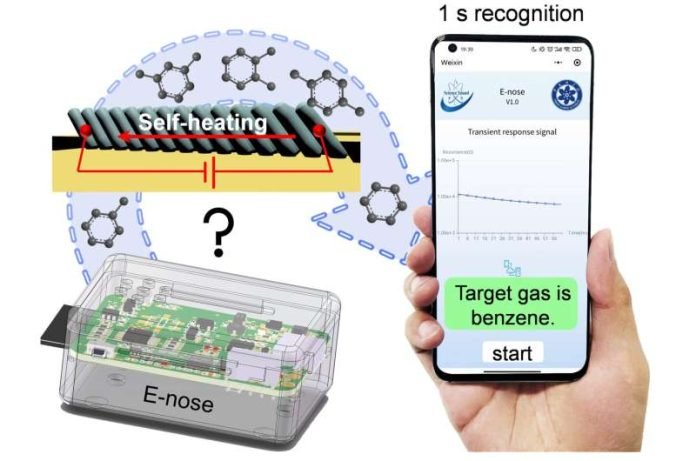
The development of a smart electronic nose (e-nose) capable of rapidly distinguishing between different types of gases in just one second represents a significant leap forward in gas detection technology.
Led by Prof. Meng Gang from the Hefei Institutes of Physical Science of the Chinese Academy of Sciences, this breakthrough, as reported in ACS Sensors, harnesses a novel self-heating modulation strategy to enhance the performance of semiconductor gas sensors, which are traditionally non-selective and slow to respond.
Traditional electronic noses rely on arrays of sensors to detect various gases, often requiring complex algorithms to interpret the data due to the sensors’ non-selective nature.
One of the longstanding challenges has been the rapid extraction of molecular features from target gases, particularly in less than a second, which is critical for the timely warning against hazardous gases like those that are explosive or lethal.
Prof. Meng Gang’s team has tackled this challenge by innovating in the area of temperature control and modulation within the sensor itself, bypassing the need for external heaters.
They used tungsten trioxide (WO3) nanorod films, prepared via oblique angle deposition (OAD), as the dual-function layer for both sensitive gas detection and stable self-heating.
The OAD WO3 sensor’s ultrafast thermal relaxation time (around 20 microseconds) allows it to rapidly modulate its temperature through self-heating, generating a quick and distinct electrical response to different gases.
This method has dramatically increased the speed of gas detection, enabling the discrimination of 12 gas molecules within 0.5 to 1 second—making it significantly faster than the capabilities of current state-of-the-art electronic noses.
Moreover, the research team developed a smart wireless e-nose system that can accurately and instantaneously identify target gases against the backdrop of ambient air, showcasing its practical application potential.
Such an e-nose system could revolutionize the fields of homeland security and public health by providing a tool for the rapid detection of harmful
gases in various environments. The ability to quickly identify hazardous gases can lead to faster response times in emergencies, potentially saving lives and preventing property damage.
Furthermore, this technology could be applied in industrial settings for monitoring air quality, detecting leaks, and ensuring workplace safety, as well as in environmental monitoring to track pollution levels and identify sources of hazardous emissions.
The innovation introduced by Prof. Meng Gang and his team, particularly the self-heating modulation strategy, not only simplifies the design and operation of e-nose systems but also enhances their efficiency and reliability.
This approach reduces the need for complex external heating elements and circuitry, leading to more compact, durable, and energy-efficient devices.
As the research progresses, it is expected that the smart e-nose technology will continue to evolve, with potential improvements in sensitivity, selectivity, and the ability to detect an even broader range of gases.
This could open up new applications in medical diagnostics, food safety, and quality control, where the rapid and accurate detection of specific gas signatures can provide valuable information.
The development of this smart e-nose technology marks a significant milestone in sensor technology, offering promising solutions for real-time gas analysis and contributing to the advancement of safety, health, and environmental monitoring.
The research findings can be found in ACS Sensors.
Copyright © 2024 Knowridge Science Report. All rights reserved.



